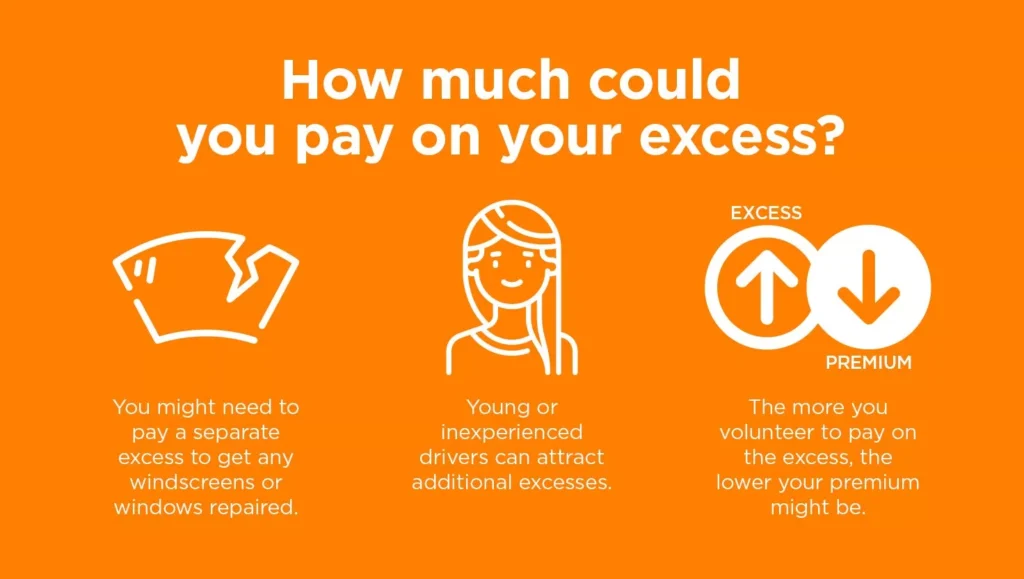Compare Car Insurance Policies
Save time and effort by comparing a range of car insurance quotes with iSelect
.svg)
 13 19 20
13 19 20
Save time and effort by comparing a range of car insurance quotes with iSelect
When do you pay car insurance excess?
Why do excesses exist?
Are there different types of car insurance excess?
Do any claims have exemptions for the excess?
Can you pay your excess in installments?
How much should I be paying?
Can I reduce my excess?
Simply put, your car insurance excess is the out-of-pocket amount you have agreed to pay when making a claim with your insurance.
For example, let’s say your standard excess is $500 and you make a repair claim for $2000. You’ll end up paying $500 while your insurer pays the remaining $1500. If your car is written off, then your excess would usually be deducted from the final claim payment you receive.
Your excess will also apply if you cause an accident or if somebody covered by your policy drives your car and ends up causing an accident. It still applies if your car is damaged where no one is at fault, or the responsible party cannot be identified.
If another party causes damage to your car and is shown to be at fault, their insurance should cover the full cost of your repairs and you shouldn’t have to pay anything out of pocket.
Okay, so we’ve established when you need to pay an excess. But that doesn’t really explain why they’re a part of insurance in the first place. After all, wouldn’t it be easier if you could simply get a policy where you don’t have to pay an excess?
While this might be true, keep in mind that insurers also want to reduce their own risk. On a policy with no excess, they could end up paying a claim for every minor scratch and dent on a policyholder’s car.
As such, an excess is their way of sharing risk. The policyholder ends up paying part of the claim with their excess and it ensures they’ll only make claims that cost more than their excess amount.
But this isn’t just for the insurer’s benefit, either. Excesses can help to make Car Insurance more affordable. Generally speaking, a higher excess means a lower premium for the customer. The higher the excess, the less risk is put on the insurer, and less money they ask from the policyholder to cover this risk.
Important
If you make a claim that’s lower than your excess, you won’t receive a payout from your insurer. For instance, if your standard excess is $500 and you make a claim for $250 worth of repairs, then you will have to pay the entire $250 amount yourself.
Yes, although a standard excess is the most common type of excess you will encounter.
This is the excess you’ll be required to pay for all claims—unless the policy specifically notes otherwise. It can vary widely depending on your provider, your car, your policy type and other factors.
But other excesses can also apply to your policy, too. These can include (but are not limited to):
These excesses can apply individually or in combination, depending on the circumstances and your policy.
As such, it’s a good idea to compare different Insurers and to review your policy and current standard excess level regularly.
This will largely depend on your insurer and the terms of your policy. However, there are definitely insurers who will waive your excesses when a no fault accident happens.
A no fault accident is pretty much what it sounds like: it’s an accident that wasn’t your fault. Instead, it was entirely the fault of another driver or another person. However, your insurer will also need that person’s full name, residential address and car registration number as part of the process.
Unfortunately, exemptions won’t usually apply to claims that involve:
Of course, you’ll still need to check your insurer’s product disclosure statement (PDS) for the specific details. In some cases, you might have to pay a standard (and voluntary excess) for certain claims, but not pay any additional excesses. It all depends on the terms of your policy.
Helpful Tip:
With smaller repairs consider whether you want to make a claim at all. By the time you pay the excess and factor in potential increases in the cost of future policies due to your claims history you may be better off shelling out the extra few hundred dollars yourself.
This can also depend on your insurer and the terms of your policy.
This being said, if you are going through some kind of financial hardship, insurers are expected to provide some options to help you pay your excess.1Australian Securities & Investments Commission – ASIC’s expectations of general insurers: responding to consumers in financial hardship (Page 4) This may include the option to pay your excess in instalments.
Keep in mind that they are not legally required to let you pay in instalments. For this reason you might wish to contact your insurer beforehand and ask them what kind of options they provide when it comes to paying your excess.
How much you pay for excess cover depends on the level of excess you choose. The higher the excess, the less you might pay in premiums, and vice versa.
Of course, a higher excess means you may end up paying more out-of-pocket if you need to make a claim. If you’re a safe driver with a clean driving history, going with a higher excess could make sense for you. On the other hand, you might prefer paying more on your premiums if it means you’ll pay less on your excess, particularly if you are a less experienced driver.
Ultimately, it’s your decision. Just be sure to review all the facts from every angle before you make your choice.

Some insurers allow you to reduce or increase your standard excess at any time. When reviewing quotes, you can try experimenting with different levels of excess to see what impact it has on your premiums until you find cover within your budget.
Here at iSelect, we can provide the advice you need to make an informed decision on your car insurance cover, including explaining how a higher excess could reduce the cost of Car Insurance.
Get a fast and free quote online with iSelect’s Car Insurance comparison tool, or call iSelect HQ on 13 19 20 and let one of our consultants find you a great policy from our range of policies and providers.*

Save time and effort by comparing a range of car insurance quotes with iSelect
iSelect does not compare all car insurers or policies in the market. The availability of policies may change from time to time. Not all policies available from iSelect’s providers are compared by iSelect and due to commercial arrangements, area or availability, not all policies compared by iSelect will be available to all customers. Some policies are available only from iSelect’s call centre or website. A number of our participating general insurance brands are arranged by Auto & General Services Pty Ltd ACN 003 617 909 on behalf of Auto & General Insurance Company Limited 111 586 353, both of which are related entities of iSelect Limited. Our relationship with those companies does not impact the integrity of our comparison service. Click here to view iSelect’s range of providers.
iSelect General Pty Limited ABN 90 131 798 126, AFS Licence Number: 334115. Any advice provided by iSelect is of a general nature and does not take into account your objectives, financial situation or needs. You need to consider the appropriateness of any information or general advice iSelect gives you, having regard to your personal situation, before acting on iSelect’s advice or purchasing any policy. You should consider iSelect’s Financial Services Guide which provides information about our services and your rights as a client of iSelect. iSelect receives commission for each policy sold that is a percentage of the premium or a flat fee. Ask us for more details before we provide you with any services.